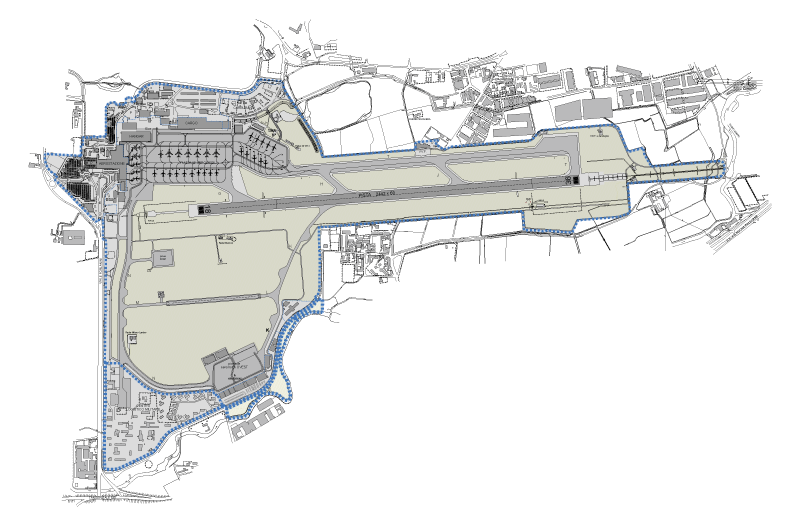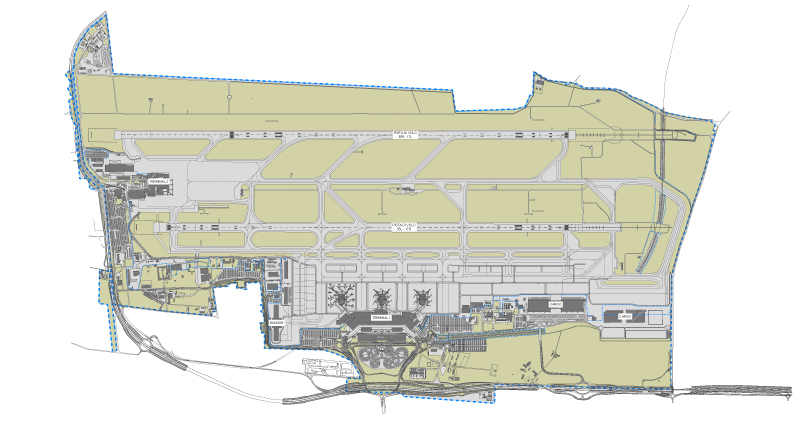Linate Airport
Linate Airport occupies a total area of approximately 350 hectares in the south-eastern part of the Province of Milan, extending into the municipalities of Peschiera Borromeo, Segrate and Milan. Forlanini Park, one of the major urban parks in Milan, and the Idroscalo lake adjoin the airport.
The airport is dedicated primarily to a frequent flyer type client, on particularly attractive domestic and international routes (these latter both within the European Union and outside). In 2018, Linate handled 5.0% of passengers, 7.2% of aircraft movements and 1.1% of cargo in Italy.2 The airport has two runways for take-off and landing, of which the first (length of 2,442 meters) for commercial aviation and the second (length of 601 meters) for General Aviation. The flight infrastructure contains a taxiway of approximately 2,100 meters, a system of link roads of approximately 4,000 meters and 2 aircraft stands.
There are 46 aircraft stands, accommodating a maximum of 42 aircraft at any given time.
The passenger area extends over 3 levels for a total area of 75,000 m2 (of which approximately 33,000 open to the public), with 73 check-in counters and 24 gates, of which 5 served by loading bridges and the remaining utilized by aircraft positioned in remote parking reachable by runway shuttle buses. 18.2% of the airport surface open to the public is dedicated to commercial activities (sales points and catering, car hire and banking services) and 7.5% to services provided by the airlines (check-in counters and ticket counters).
Linate - Plan of airside airport area

The cargo area utilizes a cargo warehouse of approximately 16,800 m2, with a capacity to handle 80-100,000 tons per year.
Linate Airport Table
| Traffic | 2018 | ∆ 18/17 | Rank ITA |
|---|---|---|---|
| Passengers | 9,187,120 | -3.3% | 7th |
| Cargo (tons/year) | 10,827 | -9.3% | 8th |
| Movements | 93,987 | -2.6% | 3rd |
| Operating standards 2018 | |
|---|---|
| Departure punctuality (delays less than 15 minutes) | 86.0% |
| Delivery of first bag within 18 minutes | 93.8% |
| Number of misdirected bags / 1,000 passengers | 1.9 |
| Infrastructural characteristics | |
|---|---|
| Surface area | 350 ha |
| No. runways | 2 |
| No. aircraft stands | 46 |
| No. check-in desks | 73 |
| No. departure gates | 24 |
| Terminal surface area dedicated to commercial activity | 18.2% |
| Cargo warehouse surface area | 16,800 m2 |
| Cargo movements capacity | 80-100 tons/year |
| Cogeneration station - installed electric capacity | 24 MWe |
| Cogeneration station - installed thermal capacity | 18 MWt |
| No. car parks | 3 |
| No. parking spaces reserved for passengers | 3,867 |
| No. parking spaces reserved for airport operators | 1,850 |
| No. taxi spaces | 169 |
Sources: SEA, Assaeroporti (www.assaeroporti.it)
Malpensa Airport
Malpensa airport is located on the Lombardy plateau in the South-West of Varese province, 48 KM from Milan, with rail connections to the city and a road system, including a Motorway, which connects the airport with the major regions of Northern Italy and Switzerland. The airport covers 1,220 hectares within 7 municipalities: Somma Lombardo, Casorate Sempione, Cardano al Campo, Samarate, Ferno, Lonate Pozzolo and Vizzola Ticino.
All airport grounds are within the Lombardy Valle del Ticino Park, the largest regional park in Italy, created in 1974 to protect the rivers and the numerous natural habitats of the Valle del Ticino from industrialization and encroaching urbanization and to safeguard the rich biodiversity heritage. The Malpensa airport ranks second in Italy for overall aircraft movements and passenger numbers.
Malpensa - Plan of airside airport area

In 2018, Malpensa managed 12.2% of overall movements, 13.3% of passenger traffic and 50.3% of cargo transported in Italy.3
The airport utilizes two parallel runways, with 808 meters between them, measuring 3,920 meters each and capable of handling all aircraft in service. The runways do not permit parallel independent approaches.
The taxiing and connection roadways cover approximately 19.4 km in total (28.5 km if considering also the stand taxiways). The 204 stands for aircraft – of which 111 at Terminal 1, 43 at Terminal 2 and 49 at Malpensa Cargo – allow a maximum stoppage capacity of 120 aircrafts.
There are 2 airports for passengers. Terminal 1, operative since 1998, was constructed according to a modular type of plan and comprises a core structure (comprising 6 floors) and three satellite structures with airport stands, from which the passenger loading bridges are connected.
The three satellites are connected to the core building by a double tunnel for arriving and departing passengers and a covered corridor for the movement of bags.
It has 255 check-in counters and 65 gates, of which 30 served by 41 loading bridges and the remaining for aircraft positioned in parking, reachable with shuttle runway bus.
Approximately 8.5% of the surface area open to the public is dedicated to commercial activities (sales points and catering, car hire and banking services).
Malpensa Terminal 2 has 35 check-in counters and 23 gates for parked aircraft reachable by runway buses.
Approximately 12.2% of the surface area open to the public is dedicated to commercial activities.
Malpensa Cargo utilizes warehouses with a surface area of 50,000 m2 and has a capacity of between 700,000 and 750,000 tons of cargo annually.
The airport has also a hangar for the recovery and maintenance of aircraft and of office use spaces.
| Traffic | 2018 | ∆ 18/17 | Rank ITA |
|---|---|---|---|
| Passengers | 24,561,735 | 11.5% | 2nd |
| Cargo (tons/year) | 558,218 | -3.2% | 1st |
| Movements | 189,910 | 8.7% | 2nd |
| Operating standards 2018 | |
|---|---|
| Arriving punctuality | 77.1% |
| Delivery of first bag | |
| Malpensa T1: bag delivery within 23 minutes | 93.1% |
| Malpensa T2: bag delivery within 26 minutes | 96.4% |
| Number of misdirected bags / 1,000 passengers | 1.7 |
| Infrastructural characteristics | |
|---|---|
| Surface area | 1,220 ha |
| No. runways | 2 |
| No. aircraft stands | 204 |
| No. check-in desks: | |
| Malpensa T1 | 255 |
| Malpensa T2 | 35 |
| No. boarding gates: | |
| Malpensa T1 | 65 |
| Malpensa T2 | 23 |
| Terminal surface area dedicated to commercial activity | |
| Malpensa T1 | 8.5% of the surface area open to the public |
| Malpensa T2 | 12.2% of the surface area open to the public |
| Baggage Handling System Malpensa T1 | 10,650 bags/hour |
| Baggage Handling System Malpensa T2 | 4,800 bags/hour |
| No. baggage delivery carousels | |
| Malpensa T1 | 10 |
| Malpensa T2 | 4 |
| Cargo movements capacity | 700-750,000 tons/year |
| Cogeneration station – installed electric capacity | 70 MWe |
| Cogeneration station – installed thermal capacity | 62 MWt |
| No. car parks | |
| Malpensa T1 | 4 |
| Malpensa T2 | 1 |
| No. parking spaces reserved for passengers | |
| Malpensa T1 | 7,158 |
| Malpensa T2 | 2,531 |
| No. parking spaces reserved for airport operators | |
| Malpensa T1 | 2,563 |
| Malpensa T2 | 1,160 |
| Malpensa T1-Malpensa T2 intermediate area | 1,609 |
| Malpensa Cargo | 1,159 |
| No. taxi spaces | |
| Malpensa T1 | 280 |
| Malpensa T2 | 20 |
Sources: SEA, Assaeroporti (www.assaeroporti.it)
(2) Source: Assaeroporti (www.assaeroporti.it)
(3) Source: Assaeroporti (www.assaeroporti.it)